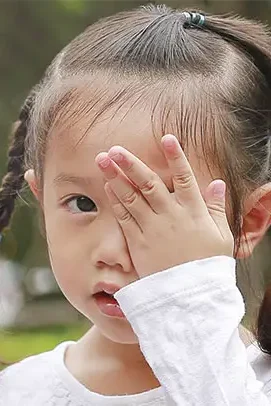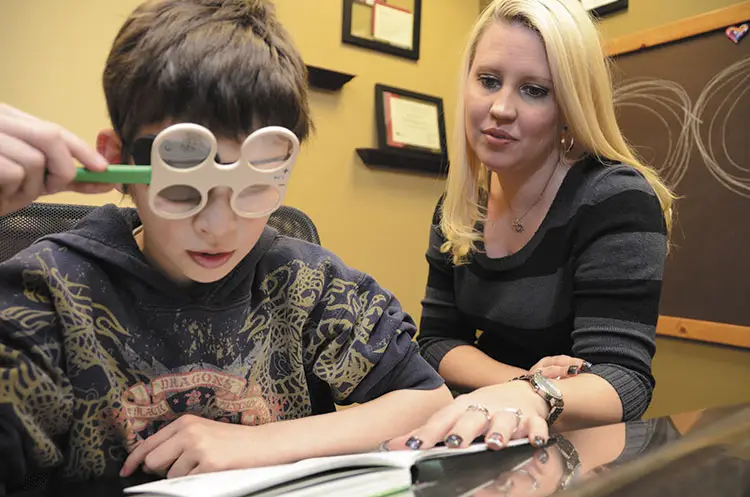Amblyopia, often called “lazy eye,” is a treatable disorder of vision development that begins during infancy and early childhood. With amblyopia, an otherwise healthy eye is unable to achieve normal visual acuity (20/20) even with glasses or contact lenses. In addition to poor visual acuity, people with amblyopia are more likely to have difficulties with eye-hand coordination, clumsiness, reading, depth perception and understanding what is seen.
In most cases, only one eye is affected but it may occur in both eyes. According to the National Institute of Health, amblyopia is the most common cause of visual impairment among children in the United States and is estimated to affect 3.5% of the US Population, despite being preventable with early diagnosis.
Clues that your child may have amblyopia include crying or fussing when an eye is covered or if the child constantly turns their head to the right or left.

WHAT CAUSES AMBLYOPIA?
There are three types of amblyopia, based on the underlying cause:
- Strabismic amblyopia: This is the most common cause of amblyopia. Strabismus is also known as an eye turn. To avoid double vision caused by poorly aligned eyes, the brain ignores the visual input from the misaligned eye and vision fails to develop properly. If you notice your baby or young child has crossed eyes or some other apparent eye misalignment, schedule a comprehensive eye exam immediately.
- Refractive amblyopia: Amblyopia may be caused by unequal refractive errors in the two eyes, despite perfect eye alignment. For example, one eye may have a significant prescription while the other does not. The brain relies on the eye that has better vision and “tunes out” the blurred vision from the other eye. It can also occur in both eyes when they each have a high uncorrected prescription.
- Deprivation amblyopia: This is caused by something that obstructs light from entering a baby’s eye, such as a congenital cataract or droopy eyelid (ptosis). Prompt treatment of the obstruction is necessary to allow normal visual development to occur.
Young children with amblyopia rarely have any symptoms. Comprehensive eye examinations are the best way to identify patients with amblyopia or those who are at risk for developing amblyopia. According to the American Optometric Association, children should have their first comprehensive eye exam at 6 months of age.
AMBLYOPIA TREATMENT
In some cases of refractive amblyopia, normal vision may be achieved simply by wearing prescribed glasses or contact lenses. Usually additional treatment is required to stimulate the brain to use the amblyopic eye and enable proper visual development.
Vision therapy is a structured program of activities prescribed to improve visual abilities and acuity. It trains the eyes and brain to work together more effectively and reinforces the connection to the amblyopic eye. During certain activities, the better seeing eye will need to be blurred in order to encourage the brain to pay more attention to the amblyopic eye. This may be done with special fogging patches.
The latest research demonstrates that binocular vision therapy is the most effective long-term solution for amblyopia. Full time patching is rarely the best option for treatment of mild to moderate amblyopia. If patching is indicated, most cases of amblyopia will show improvement with just 2 hours of fogged patching per day in combination with specific visually stimulating activities. For additional resources, please visit www.amblyopiaproject.com.

CHILDREN WILL NOT “OUTGROW” AMBLYOPIA
Amblyopia will not go away if left untreated and can lead to permanent visual problems. An injury or disease in the better seeing eye in the future will leave the person depending on the poor vision in their amblyopic eye, so it is best to treat amblyopia as early as possible.
Modern amblyopia treatments may improve vision in older children and adults, but early detection and treatment is the best chance for normal visual development and optimal visual outcomes.
In addition, best corrected visual acuity of worse than 20/40 in the better eye may require a person to have a restricted driver’s license in Colorado. This could mean a number of restrictions, including no driving at night or during rush hour, no freeway driving, a restricted geographical area the person must stay within and requiring the addition of extra mirrors to the vehicle.
Protect your vision for life! Call Highline Vision Center to schedule a comprehensive eye exam today.
Ready to Schedule An Appointment?
The Highline Vision Center team is looking forward to seeing you soon. Our practice utilizes state-of-the-art technology to deliver personal and comprehensive eye care for your entire family.
